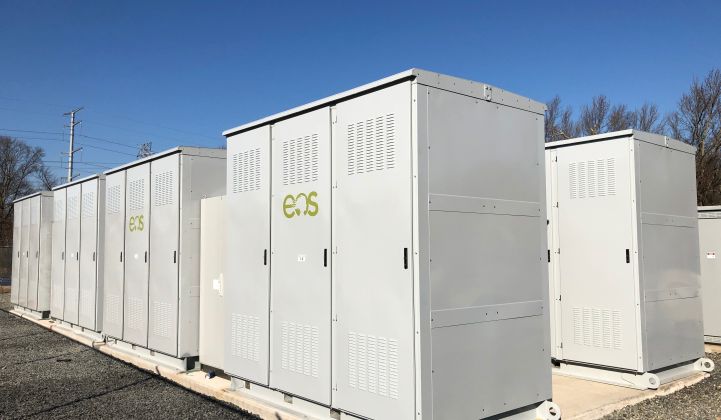Eos Energy Storage, a rare non-lithium-ion grid-scale battery contender in an increasingly lithium-ion-dominated world, is gearing up for multi-gigawatt manufacturing.
Last week the Edison, New Jersey-based battery company inked a deal with Holtec International, mostly known in energy circles as a front-runner in the race to commercialize small modular reactors, to create a manufacturing joint venture to produce Eos’ Znyth aqueous zinc batteries.
The venture, Hi-Power, is an extension of a strategic partnership that has been in place since August 2018.
The new company “will leverage a combination of Eos’ proprietary, automated battery design and Holtec’s more than 30 years of market-leading automation and manufacturing experience to build a state-of-the-art manufacturing facility in Pittsburgh,” according to a press release.
Rick Springman, Holtec’s vice president of international projects, was careful to position the move into battery manufacturing as additional to the company’s nuclear program.
“Although we continue to invest in our nuclear business and believe in the future of our small modular reactor program for low-carbon baseload energy, we recognize that renewables must also play a critical role in reducing carbon emissions going forward,” Springman said.
The Engie test program led to an order for a 1-megawatt/4-megawatt-hour storage system in Brazil in 2017. But that same year, Eos confessed to having problems in scaling up its battery systems.
The company did not launch its products commercially until 2018, by which point it had manufactured more than 2,200 batteries and commissioned almost 1.8 megawatt-hours' worth of systems.
Even though Eos’ manufacturing expansion announcement suggests some of its scaling challenges have been overcome, recent deployments remain modest in size compared to what’s happening in the lithium-ion world.
A confidential company update seen by GTM from the third quarter of this year lists nine deals in the last 12 months, totaling 1.3 megawatts/4.6 megawatt-hours of capacity. For comparison, Tesla installed 415 megawatt-hours of energy storage in the second quarter of 2019 alone.
The Eos update states the company has delivered a total of 52 megawatt-hours of capacity to date, with deployments on four continents and 4,600 hours of operation.
Eos has already established two manufacturing locations and produced 3,000 of its second-generation batteries, the update said.
The batteries have been shown to go through more than 1,800 cycles with a 100 percent depth of discharge and a temperature operating range of 12 to 113 degrees Fahrenheit, it said. It also quoted a DC system cost of $222 per kilowatt-hour.
This compares to a National Renewable Energy Laboratory estimate of $380 per kilowatt-hour for a 60-megawatt, 4-hour lithium-ion battery. But that estimate was produced almost a year ago and so is unlikely to reflect continuing strong declines in the price of lithium-ion batteries.
The current Eos cost also contrasts with a price of $160 per usable kilowatt-hour that the company was touting in 2017. At the time, Eos said it would accept orders at $95 per usable kilowatt-hour, including batteries, battery management system and an outdoor-rated enclosure, for systems shipped in 2022.
The safety argument
As well as trying to compete with lithium-ion on cost, Eos claims to have a battery chemistry that is inherently safer, playing on fears sparked by blazes in South Korea and the U.S., as well as one that is not reliant on scarce resources such as cobalt.
Daniel Finn-Foley, head of energy storage at Wood Mackenzie Power & Renewables, said: "Alternative battery companies have legitimate arguments to make when comparing technologies on safety, efficiency, degradation rates and commodity risk. But if they want to dethrone lithium-ion, they will ultimately have to demonstrate that they can be cost-competitive as well.”
Finn-Foley said the manufacturing and sales ramp-up outlined by the vendor this month were “positive steps toward building scale.”
However, he added, “Only time will tell if it drives down costs enough to allow Eos to emerge as a true lithium-ion challenger."



